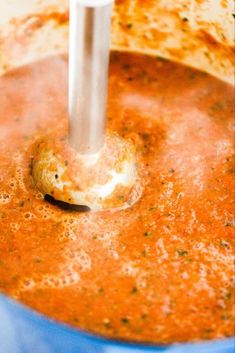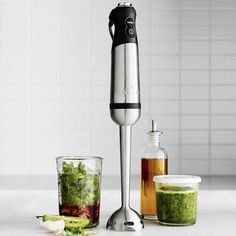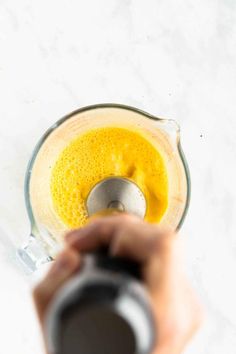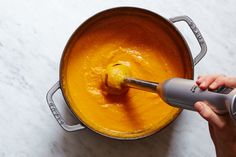What Is the Best Way to Use an Immersion Blender for Soup?

Last night, I prepared a fantastic minestrone soup. I wondered how to make a soup using an immersion blender if I wanted it to be less chunky.
Here’s what I discovered after doing some research.
Immersion blenders have a small blade at the bottom of a long handle that spins. A wide-mouthed bottom protects the blade and prevents spillage (to a degree). Because of the immersion blender’s compact size, it’s ideal for mixing thick soups as long as the bits aren’t too hard or large.
An immersion blender is affordable, easy to store, and easy enough for anyone to use, including my daughters. Does it, however, purée well enough to produce a creamy soup?
So, if you’re ready to learn how to make soup with an immersion blender, let’s get started, shall we?
What is an immersion blender, and how does it work?
A little blade spins at the bottom of a long handle in an immersion blender. The blade at the end of the handle is partially hidden by the handle’s wide-mouthed bottom and is put into the pot of food to be blended.
The immersion blender’s large aperture helps prevent spatter (to a degree). Because the immersion blender is a hand tool, it can be used anywhere in the kitchen, whether it’s in a mixing bowl on the counter or a pot on the stove.
Because of the immersion blender’s compact size, it’s ideal for mixing thick soups as long as the bits aren’t too hard or too large.
Immerse the immersion blender in the soup or drink you want to purée. Then, with a gentle push of the trigger, pulse or hold until the required consistency is achieved. To make sure you hit everything, you’ll need to move it around in the bowl or pot. When mixing, be careful not to pull the blade out of the liquid, as this might cause splatter (which will be hot if it’s a cooktop item).
The metal wand section usually comes apart with a single click and may be thrown in the dishwasher. Alternatively, rinse the part in the sink and go on to the next project. Almost no other little kitchen equipment works as well, as quickly, or as easily as this one.
Can I make soup without an immersion blender by using a hand mixer?

No. A hand mixer will not be able to completely substitute an immersion blender in most situations, especially when pureeing significant bits of vegetables.
Let’s have a look at how they function
A blender’s mechanism of action
A blender converts solid food into liquid at its core. It works by having a little blade at the bottom of the blender spin very quickly, cutting up food as it comes into contact with it.
Blenders usually have multiple speeds for jobs that are easier or more difficult. To work correctly, they also require some liquid at first. To put it another way, blending a bunch of apple slices won’t make an apple smoothie; at best, it’ll turn into extra chunky applesauce.
The workings of a mixer
On the other hand, a mixer combines (mainly) dry ingredients. It is focused on thoroughly mixing all of the ingredients so that all flavors are evenly distributed.
They work by using one or two wands that aren’t as sharp as a blender’s blade. The wands (or paddles, as they’re often known) spin (at various speeds) and blend the materials. Even though they are quick, they would struggle to slice cooked potatoes or carrots.
A mixer is plainly designed for baking, but it isn’t designed for smoothies or soups. On your small kitchen appliances list, each plays equally vital duties, yet those roles are somewhat different.
A hand mixer and an immersion blender are thus the younger cousins of a regular blender and mixer. They are only portable and have weaker motors. However, if you want to learn how to use an immersion blender for soup, you should avoid using a mixer.
What can you use an immersion blender for?

It’s recommended to use an immersion blender to make:
- Soups made with ingredients that have already been cooked on the stovetop
- Pesto
- Cream whipped
- Mayonnaise
- Dressings for salads
- Getting rid of lumps in pancake batter
But don’t be concerned. In a moment, I’ll go over those in further depth.
Immersion blenders are ideal for blending and pureeing on the stovetop. They can be easily held with one hand and usually come with a lengthy cord.
They offer a wide range of applications, are relatively compact, and are extremely easy to clean. They’ll make your life in the kitchen a lot easier on a regular basis, especially considering the low price! Immersion blenders cost between $30 and $60.
An immersion blender, also known as a hand blender or stick blender, speeds up the process of puréeing, emulsifying, or mixing items together.
Sure, you could use a whisk and work till your arm hurts, or you could gently pour that enormous pot of soup into the tiny opening of your blender or food processor, but why? With an immersion blender, you can achieve the same results in a fraction of the time, with less mess and a less sore arm.
So, what are the most effective applications for an immersion blender?
Pesto is a delicious Italian condiment.
Combine fresh basil leaves, pine nuts, a few fresh garlic cloves, grated parmesan cheese, and extra virgin olive oil in a blender and process until smooth.
Soups with a Creamy Flavor
On the stovetop, boil your ingredients and broth until they are soft. Then, carefully dip your hand blender into the soup and pulse until the appropriate degree of puree is achieved. When blending, be careful not to get the blade too close to the surface, or it may splatter.
Amazing Creamy Whipped
Is there anything better than homemade whipped cream that isn’t canned?
No, I don’t believe so! Combine heavy whipping cream, a dash of vanilla extract, and a tiny amount of powdered sugar in a large mixing bowl and whisk until the mixture is more firm than liquid.
To Die For Mayonnaise
It’s OK if most of us receive our mayo from a jar. However, once you’ve tried fresh mayonnaise, you might never go back! Combine egg yolks, a high-quality, low-flavor oil, and a bit of salt in a mixing bowl. Begin with just the yolks, lemon juice, and salt. Gradually trickle in the oil until you get the desired mayonnaise consistency.
Pancake Batter with No Lump
There will be no more lumpy batter! You can make fluffy, tasty pancakes in minutes with your immersion blender. Don’t bother with your old beaters, and don’t even consider using a whisk! The immersion blender will smooth out all those lumps in seconds, resulting in some incredibly delicious and fluffy pancakes.
Salad Dressings with Gums Most store-bought salad dressings contain gums to keep the components mixed together.
They can also have cheap vinegar and low-quality oil. You’ll never go back once you understand how superior a freshly made salad dressing with high-quality ingredients is. Combine a tablespoon of dijon mustard, balsamic or red wine vinegar, and a pinch of salt and pepper.
Then, if desired, add a fresh garlic clove and any fresh herbs. Begin blending while carefully pouring in extra virgin olive oil, just like you did with the mayo.
Is it possible to purée using an immersion blender?

Yes, you can use an immersion blender to purée. While an immersion blender may certainly blend, it excels at blending quickly enough to produce a creamy, smooth purée. Puree, or purée as it’s spelled, is “a smooth, creamy substance made of liquidized or crushed fruit or vegetables,” according to the dictionary. Puréeing soups with an immersion blender is a breeze.
Because an immersion blender admits more air into the blended mixture than a standard blender with a sealed cover, it’s ideal for whipping up a frothy foam on ultra-creamy creamy soups.
Have I answered all of your questions on how to make soup with an immersion blender?
We did a deep dive into the world of immersion blenders in this post. This wonder equipment allows you to blend right where you’re cooking instead of having to move the food to a countertop blender.
We looked at how they operate, why they’re so good, and what they DO and DON’T do well. However, we focused on how to utilize an immersion blender for soup in order to achieve flawlessly blended soup every time in an EASY manner.











